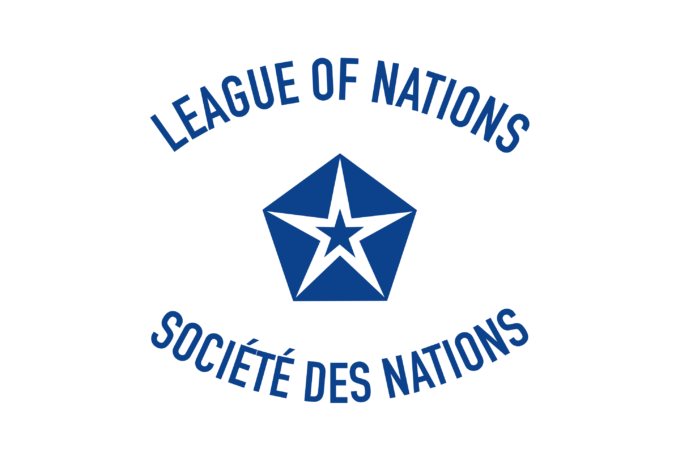The End of the United Nations at a League of Nations Moment?

Flag of League of Nations – CC BY-SA 4.0
“The League is dead,” Robert Cecil solemnly declared on April 18, 1946, addressing delegates from 34 countries at the League of Nations headquarters in Geneva. The death of the League was not the immediate end of a worldwide international organization dedicated to cooperation, negotiation and the rule of law. After announcing the end of the League, Cecil did say right after announcing the League’s cessation, “Long live the United Nations.” The birth of the U.N. was included in the League’s termination. But could we now be witnessing the death throes of the U.N. with no future organization on the horizon? Can we imagine someone in the near future saying, “The United Nations is dead” without a follow-up?
The panic in Geneva these days is palpable. International Geneva with its 40 international institutions and 750 non-governmental organizations is under attack. Donald Trump’s assaults on international cooperation, be they unilateral tariff increases, withdrawing from the World Health Organization and the Paris Climate Accords or gutting the U.S. Agency for International Development which distributed $43.79 billion in foreign assistance in fiscal year 2023 are sending tremors throughout the City of Calvin. Over 35,000 internationalists in Geneva are wondering how and if they will continue functioning under the Trump administration. Without United States funding, many of the multilateral and civil society bodies will no longer be fully operative with global consequences for millions dependent on multilateral aid and assistance; many aid workers will lose their jobs.
President Trump is downsizing the United States’ foreign presence in a similar fashion he is downsizing the United States government. The United Nations and many of its specialized agencies as well as global voluntary organizations are obvious targets in the Musk/Trump culling of public institutions.
Historically, the U.S. has not always been in the forefront of multilateralism. Jennifer Mittelstadt recently described what she called this American “sovereigntist” tradition. The United States was not one of the High Contracting Parties to the League of Nations. Although President Woodrow Wilson’s 1918 Fourteen Points included a “league of nations to ensure peace and justice,” the Senate refused to ratify the Versailles Treaty.
But it was not only the U.S. non-presence that caused the League’s ending. The League of Nations’ downfall is primarily associated with its inability to stop Italy’s invasion of Abyssinia (Ethiopia), Japan’s invasion of China, and the Soviet Union’s invasion of Finland. Today, with the United States present at the U.N., the League’s failures are similar to the U.N.’s inability to curtail the Russian invasion of Ukraine or change Israel’s genocidal actions in the Middle East.
Is the U.S.’s presence a cause of the U.N.’s downfall? Although one of the moving forces behind the establishment of the U.N, the U.S. has been instrumental in the United Nations’ decline. By continuing to support Israel in the Security Council and supplying weapons to Israel despite repeated international condemnations of the Israeli government and Prime Minister Netanyahu, the U.S. is undermining the U.N.’s legitimacy. The Global South dismisses U.S. hypocrisy in supporting Israel while condemning Russia’s invasion of Ukraine. Trump’s threats to Panama, Mexico, Canada, Colombia and Denmark are diametrically opposed to the peaceful resolution of disputes and challenge the U.S. publicly prioritizing the rule of law. So while sovereigntists may prioritize nationalism within sovereign equality, Trump’s MAGA sovereigntists prioritize U.S. sovereign domination by the use of force, including threats.
This is why “America First” is fundamentally anathema to international cooperation. Although each country has its own interests, working together on global issues like climate change or resolving disputes through peaceful negotiations or arbitration is a form of enlightened self-interest. Some form of global order depends on universally accepted guidelines. As an example of self-destruction, Trump seems determined to start trade wars even with U.S. allies and neighbors. The General Agreement on Tariffs and Trade (followed by the World Trade Organization (WTO)) was designed to settle trade disputes peacefully. How can a country cry trade “victim” when the U.S. continues to block the functioning of the WTO’s Appellate Body which is authorized to arbitrate free and fair trade?
International order requires functioning international institutions, peaceful negotiations and diplomacy. The League of Nations came about because rational people tried to stop a repetition of the horrors of World War I. The United Nations came about because rational people tried to stop a repetition of the horrors of World War II. We shouldn’t need another world war to understand the importance of international cooperation. Independent, autonomous countries living in co-existence is no longer possible. The German philosopher Hans Jonas, for example, wrote about the necessity of cooperation in the technological age. Contemporary interdependence facing global challenges such as climate change and pandemics requires cooperation.
A revisiting of soft power is in order. Rather than hard power sword rattling, a return to soft power is needed. “[W]hen one country gets other countries to want what it wants might be called co-optive or soft power in contrast with the hard or command power of ordering others to do what it wants,” wrotethe Harvard scholar Joseph Nye in his 1990 book, Bound to Lead: The Changing Nature of American Power. Dialogue, compromise, and consensus are all part of soft power. The end of the League came about when countries relied on hard power to settle their disputes. Trump continues to use hard power even domestically by not following the Constitution. New York real estate salesman wheeling and dealing is not the same as following the rule or law internally as well as in foreign affairs as president.
The United Nations is now at a similar inflection point to the League’s position in the 1930s. When the League ended, the United Nations and several of its agencies became operative. Today, the United Nations and many of its specialized agencies are failing in their primary roles of maintaining international peace and security and promoting international justice. While some specific agencies continue to carry out their mandates, the overall organization is failing.
Are we witnessing the U.N. going the way of the League with no other worldwide international institution ready to take its place? Instead of blaming the League’s termination on a U.S. passive failure, today the decline of the U.N. can be traced to active U.S. policies. If the U.N. goes the way of the League, this time the major culprit clearly sits at 1600 Pennsylvania Avenue

